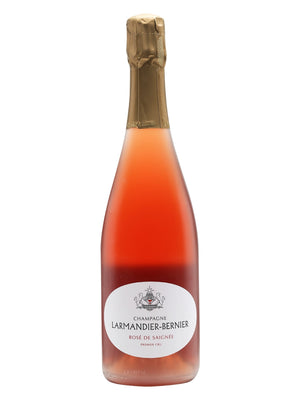- Our Shop

$149.99
Made exclusively from estate-harvested Pinot Noir grapes, this rosé earned a score of 93 points from Robert Parker.
Order from the Largest & Most Trusted Premium Spirits Marketplace!
Featured in
NOTICE: Many other small liquor store sites will end up cancelling your order due to the high demand, unavailability or inaccurate inventory counts. We have the ability to source from a large network of licensed retailers to insure in most cases your order is fulfilled.
Size: 750ML
Proof: 25 (12.5% ABV)
Origin: France
Distillery: Maison Larmandier-Bernier
Larmandier Bernier Ros√© de Saign√©e is made exclusively from Pinot Noir grapes harvested on the Maison Larmandier-Bernier estate. “We do not buy grapes from outside of our estate,” says Larmandier. “We could not vinify in the same way if we did not have total confidence in our grapes.” After the grapes have been harvested by hand, they are gently pressed, macerated and fermented with natural, airborne yeasts. “At Larmandier-Bernier, the natural yeast is not a selection of estate yeast used again and again each year nor is it the first vat to begin its fermentation which is spread around to all the other vats.” Rather, the natural yeast changes annually and is the product of the cru, its topography and the weather, which allows certain strains of yeast to thrive. Once the champagne has been fermented, it is bottled (generally at the end of July) and matured for two years in Maison Larmandier-Bernier’s cellars. The cellars are dug out of chalk, and as a result, maintain a constant temperature throughout the year. Following maturation, the champagne is disgorged with 3 grams of sugar and bottled by hand. The ros√© earned a score of 93 points from Robert Parker, who said it was “one of the most profound wines I encountered in my tastings.”ÔøΩ
Nose: Blood orange color, along with a rich aroma of citrus and minerals.
Palate: Aroma gives way to notes of peach nectar, honey, strawberries and orchard-fresh apples.
Finish: Finishes with a delicate touch of raspberries and melon.
Situated on a 15-hectare estate in the C√¥te des Blancs region of France, Maison Larmandier-Bernier was founded in 1971 when Philippe Larmandier married Elisabeth Bernier. Two decades later, their son ‚Äî Pierre Larmandier ‚Äî took over the family estate and began focusing his energies on rejuvenating its terrior. “The creation of a great Champagne, like the creation of any great wine, begins in the vineyard,” says Larmandier. “Our vines are cultivated with respect for the terroir and respect for the balances of the plant throughout the growing period. In this way, the yields are naturally moderate and the wine shows its appreciation, through both its structure and its maturity.”
Only logged in customers who have purchased this product may leave a review.
Bourbon Bridges Ltd ©2024 Privacy Policy

THE ALCOHOL PRODUCTS ON THIS WEBSITE ARE INTENDED FOR ADULTS ONLY.
By entering this website, you certify that you are of legal drinking age in the location in which you reside (age 21+ in the United States).
Reviews
There are no reviews yet.